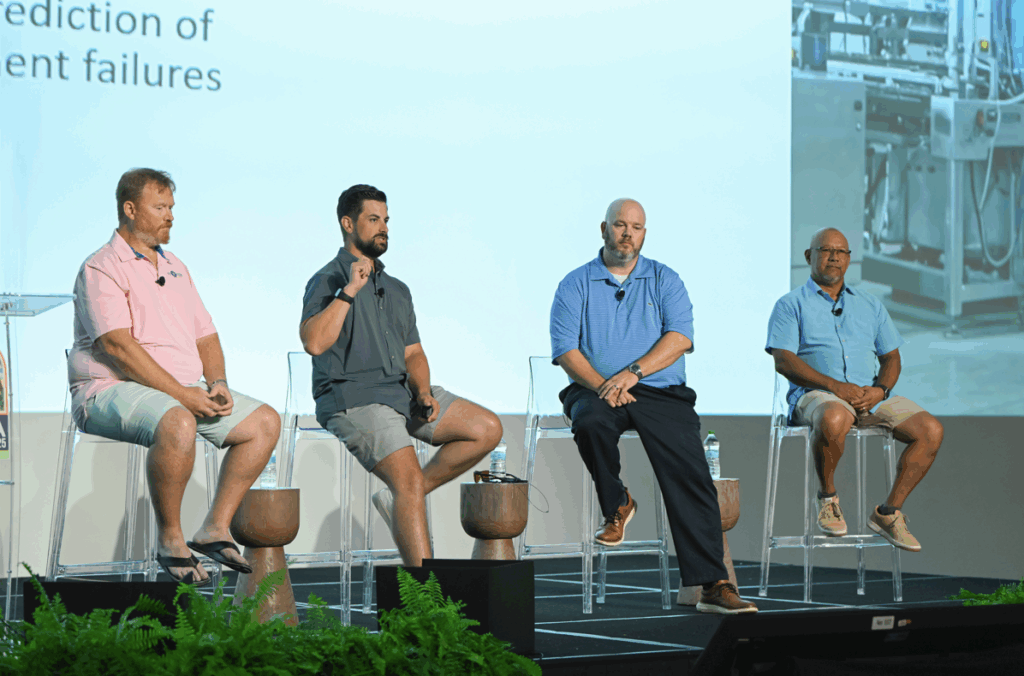
Artificial intelligence is a hot topic in every industry as it is quickly and continuously transforming the way people work. That’s true in the baking industry, as well, as shown by the attendance at the AI panel presentation, From Tasks to Transformation: AI Across the Product Spectrum. Panelists are members of the Baking Industry Forum; a group of bakers and suppliers that come together to discuss issues that affect both sides of the baking industry.
 Chad Larson, vice president and chief operating officer of Mel-O-Cream Donuts International; Justus Larson, vice president of operations for US Bakery; Brandon Brilliant, general manager of AMF Bakery Systems; Richard Ybarra, senior manager of manufacturing engineering for Publix Super Markets, Inc.; and Mike Porter, president and chief operating officer of New Horizons Baking Co. left our attendees with plenty to think about when it comes to incorporating AI into their businesses.
Chad Larson, vice president and chief operating officer of Mel-O-Cream Donuts International; Justus Larson, vice president of operations for US Bakery; Brandon Brilliant, general manager of AMF Bakery Systems; Richard Ybarra, senior manager of manufacturing engineering for Publix Super Markets, Inc.; and Mike Porter, president and chief operating officer of New Horizons Baking Co. left our attendees with plenty to think about when it comes to incorporating AI into their businesses.
History of AI
Larson introduced attendees to a little bit of the history surrounding artificial intelligence, including the surprising fact that AI originated in the 1950s, much longer ago than most people think.
AI can seem complicated and overwhelming, but Larson simplified: “It’s taking this whole idea of math and applying it to something to make the world faster.”
While AI has a multitude of applications, when it comes to the baking industry Larson said it all boils down to this: “Do more with less.”
Production Impacts
Incorporating AI into production lines can seem daunting. Where does AI help the most, and what can it not do?
Brilliant addressed those questions and more. When looking at applying AI to production lines, companies need to look for ways AI can help them improve operational efficiency, reduce waste, and lower energy consumption.
However, none of this happens overnight. Machine learning and industrial AI are going to have the most impact on the baking industry, and both of those types of AI require time to learn. With machine learning, you’re going to “get stronger and stronger performance and more accurate decisions out of machines as they consume larger and larger pools of data,” Brilliant said.
Industrial AI is a specific type of AI that “analyzes sensor data to create actionable insights,” he said.
All of this means that eventually bakers will have both vertically and horizontally integrated production lines. Vertical integration will come through individual machines that can self-optimize while horizontal integration will have machines communicating with each other to optimize the entire line’s production.
“The moonshot vision and goal is that you have a production line linked to your ERP system,” Brilliant said. “It’s going to automatically produce to your customer orders and it’s going to develop its own schedule that’s the most efficient based on what available resources you have at the moment.”
People and AI
It may sound like AI is going to replace all the people in your plant, but that isn’t true. However, the skills the people working on your production lines are going to need are changing, and AI can help with recruiting and retaining the right people that are willing and prepared to upskill.
“We had our admin go to a training and a comment made to her is that it will not eliminate jobs, but it’ll be those who understand how to use AI who will take those jobs,” Porter said. “So, it’s important for us to utilize the AI and not be afraid of it, especially when it comes to people.”
AI can help not only hire and onboard new employees, but it can create career plans and progression maps, automate administrative human resources tasks to free up HR personnel to interact with employees, do a rapid analysis of surveys and feedback to shorten the time between receiving feedback and making changes, and allow for consistent communication and standardized practices across multiple facilities.
In addition, companies that embrace new technologies are more appealing to the next generation of workers.
“We have to meet them where they’re at,” Porter said. “We have to adapt to them because I can tell you they’re not going to adapt to us. And what Gen Z’s are looking at is they love technology. They want to understand it.”
Custom AI
One of the most useful things about AI is the ability to customize it for your specific company. Most people are familiar with general AI like ChatGPT that are trained on a wide variety of information, but increasingly, companies are relying on custom agents trained only on a company’s own materials, Larson told attendees.
Custom AI agents can place all of your company’s institutional knowledge into a format that allows employees to get answers right away instead of having to wait for the one 20-year employee who knows that specific information to come to work, making your operation more efficient and eliminating down time.
AI Implementation
While AI sounds great, and it can solve a lot of problems, implementing it does come with some challenges. Ybarra addressed some of those challenges that include security restrictions, technical requirements, and outdated, unstructured data.
When implementing AI, it’s important to take security into account. You don’t want to pull in outside data that can corrupt your own system. You also need to make sure that your servers and computers can handle the immense resources it takes to run AI. Last, you have to tackle digitizing your data, including those old, greasy manuals that contain key information.
Ybarra talked about his own search for data to enter into Publix’s AI model. While he found some more recent information that was already in PDF format, he also found plenty that wasn’t.
“Everything else is what I call dumb data,” he said. “It means it’s been copied six or seven times over. It’s got wrinkles. It’s got grease all over it. So how do you take that information and make it usable in an AI model?”
Publix has gradually rolled out AI by building a digital foundation using internal documents and gradually rolling out AI tools. In addition, they have collaborated with their internal IT and automation teams to make sure the data is safe, and their tools are scalable.
Evaluate your options
In closing, Larson encouraged attendees to evaluate their own businesses to decide where to start incorporating AI.
“Really diving in and going “OK, what’s going to be the biggest impact for our team and figuring that out is probably your best first step.”

